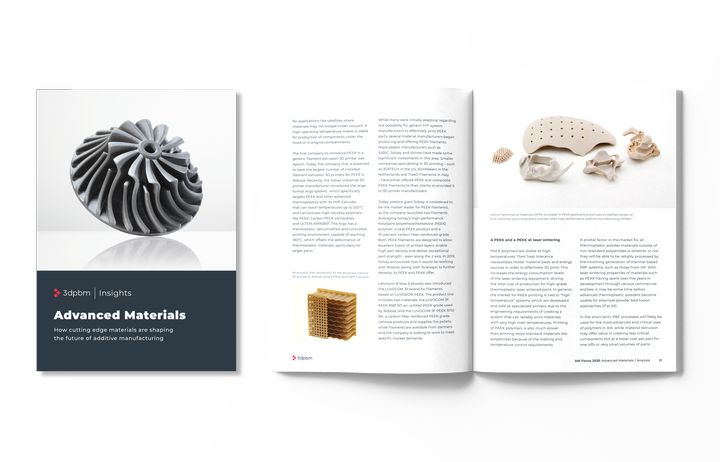
This week’s selection is the eBook “Advanced Materials” by 3dpbm.
Our friends at 3dpbm have developed a rather comprehensive eBook entitled “Advanced Materials”. The 52-page tome includes a number of stories focused on the topic of advanced materials in SLA, ceramics, composites and production.
At the outset, 3dpbm defines five categories of advanced materials used today in additive manufacturing:
- Ceramics
- Composites, in particular continuous carbon fiber options
- Refractory metals, which are highly resistant to wear
- PAEK family polymers, including PEEK and PEKK
- Bioprinting
These five, I would agree, are at the edge of the envelope in 3D printing that’s commercially available today. There are more advanced materials in the works at various research labs, and perhaps they will add to this list in the future. But for now, the most advanced 3D printing being undertaken by business involves one or more of the above categories.
I’m particularly interested in the refractory metals segment, which is still quite early in the industry. These metals — which include materials such as tungsten, molybdenum, niobium, and tantalum — are notoriously challenging to produce parts with using any process. It may be that upcoming methods of 3D printing these materials could open up new applications.
3dpbm has an association with SmartTech Analysis, which provides analytics and analysis for the 3D print and additive manufacturing industries. As such, the book includes several charts that break down business interest in the several advanced materials segments.
The book includes a long discussion on 3D printed ceramics, including a focus on these materials:
- Alumina
- Alumina Silica
- Zirconia
- Cordierite
- Tri Calcium Phosphate
- Silicon Nitride
- Hidroxyapatite
- Fused Silica
- Alumina Zirconia
- Aluminum Nitride
I was not aware all of these ceramic materials were available for 3D printing, but in fact they are.
The book contains an interesting case study examining how some of these advanced materials were used by a Greek sports car designer. What’s interesting is that the designer applied a unique form of generative CAD design to produce the necessary 3D models for the project.
There’s certainly some interesting information in this eBook, and the price is definitely right: free to download.
Via 3dpbm
